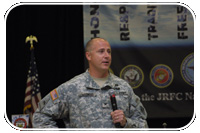USACE collocation committee meets in San Diego
Written by Greg Fuderer
 Col. Thomas H. Magness, district commander for the U.S. Army Corps of Engineers Los Angeles District, delivers opening remarks June 2 at the Collocation Meeting held in San Diego. The annual meeting provides an opportunity for Defense Department agencies to address leases and other real estate issues associated with recruiting facilities. Photo by Greg Fuderer Williams, the chairperson of the U.S. Army Corps of Engineers’ Collocation Committee, referred to comments Col. Thomas H. Magness, Los Angeles District commander, gave June 2 at this year’s Nation Collocation Meeting in San Diego, Calif. The Joint Recruiting Facilities Committee holds the annual meeting to bring realty specialists and assets management program managers together to determine the needs of the Armed Forces’ recruiting elements and to devise methods to meet those needs in the most fiscally responsible manner. The message Magness gave was simple. It follows one of the Army’s earliest and most basic tenets. The mission is more important than any one individual, and by working together, larger goals can be accomplished.
“The Army Corps of Engineers is doing things it has not done since World War II,” said Magness. “Our program is the largest it’s been in a generation. We are engaged in national issues: immigration, the national border, recruiting, the global war on terror. These are heavy missions, and we are here to support you.” In order to accomplish the mission, Magness said program managers needed to examine three issues: What are we learning? Where are we going? How can we employ the concept of synergy? What we are learning
“A program usually runs on its own until something goes wrong,” Magness said, “That’s usually the result of a breakdown in communications.”
He stressed the need to use the latest technology to enhance communication between and among elements.
“It is unacceptable if we can’t answer your calls,” he said. “We must be responsive to provide what you need for your facilities.” Where we are going
“If we are not engaged, if we do not have a forward presence,” Magness said, “it will be harder to get people into the Army.”
Magness used the example of lessons learned by troops in Iraq. “We used to have big bases. We’d go out and come back,” he said. That policy has changed. Soldiers and Marines now employ Forward Operating Bases. “Now we’re engaged. We have smaller bases, smaller footprints. We’re in the communities and developing relationships and trust. We have better communications.” Magness sees the same benefits by applying that practice to recruiting responsibilities. He used the example of a recruiter in Santa Barbara. “Recruiters can’t afford to live there,” he said. “We need to make them part of the community. We need to develop new tools. Just as we came up with new tools in Iraq, we need to do the same here.” Magness suggested for consideration increasing the number of recruiting stations and examining the practice of joint recruiting facilities. “We need to come up with a smaller footprint, not one-eaches,” he said. Separate facilities increases the workload and the number of leases. “We need to develop new tools.” Sidewinder Seven
The most coveted position in Engineers’ training, the senior engineer trainer, is Sidewinder Seven. Magness reached that position at Fort Irwin and was shortly informed that henceforth there would be no more engineer battalions.
“Sidewinder Seven, you’re now in charge of military intelligence, signals, engineering, military police, chemicals,” he said. “All different animals now, a special troops battalion.” “What I saw,” Magness said, “the concept I want to leave you with, is the element of synergy. The whole is greater than the sum of the parts. Together, we are better than we are by ourselves.” How to get there
Magness closed his comments by offering attendees some methods to reach the goals he had suggested:
• Subordinate yourselves to the overall mission. Work together as Armed Forces, not separate Army, Navy, Marine Corps, Air Force and Air Force Reserve components. Big team, little me. • Be accountable. Shared space means shared responsibility. The mindset cannot be just about one’s self or one’s service. It’s a team effort. • Develop interdependence. Share common assets: one front office, one administrative support, one copy machine, one maintenance contract. • Display leadership. Greatness doesn’t happen by itself, you have to make it greater. One has to believe the mission is bigger than one’s self. Look for ways to come up with new tools, develop ways to become more efficient, explorer ways to move resources to where they will have the greatest benefit. “Synergy fits in with collocation,” Magness said. “Team does not equal little old me.” |